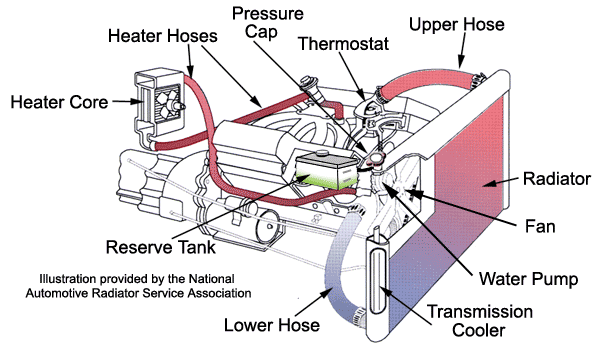posted on
Tags: Car
I was getting some late night Taco Bell the other night. As I was parking, my engine sounded funny and I thought I saw the check engine light on before I turned off my car. Trying to turn it on again, my engine turned over, but immediately died. And then I noticed that the engine temperature gauge was in the red zone.
Upon inspecting the car from the outside, I noticed a large leak beneath the car. I rubbed some between my fingers, took a whiff, and determined that it was not water. So probably something important. Turns out, it was coolant fluid.
An engine is supposed to run roughly just below the boiling point of water. After raising beyond that temperature, it is possible that overheating will cause damage to then engine. The main issue I’ve read about caused by driving a car with an overheated engine is damage to the engine’s head gasket. The head gasket provides a seal between two parts of the engine. High temperatures can cause it to warp and break the seal. If this happens, you may see smoke coming out of your tailpipe due to the leaking of car fluids no longer sealed out by the head gasket.
I’m not sure how long my car had been overheating before I turned it off and tried to turn it back on. I was told that the engine dying after I tried to turn it on while it was overheated could have been a mechanism of the car to prevent damage from occurring. Suspecting that the leaked fluid beneath my car was coolant, I could’t immediately check on the coolant level since it is unsafe to open the radiator cap when the engine is hot. This is due to the cooling system being pressurized.

Coolant fluid’s function is to absorb heat produced by the car engine and disperse it into the air. The most obvious component of the system is the radiator located near the front grill of the car. This is where the heat from the engine that the coolant absorbed is dispersed. The radiator is designed to expose a large surface area of the coolant to air coming through the car grill, whether from driving or from fans blowing on the radiator. This air absorbs the heat from the coolant. Now this cooled coolant can go back to the engine and absorb more heat.
This cooling system was not working properly in my car. One can guess that the lack of coolant flowing through the system was the cause as evidenced by the amount of coolant that leaked. Unfortunately, I was unable to identify the source of the leak. After bringing it into a mechanic, he said he suspected that the radiator was cracked.
Instead of getting the car towed immediately, I left it in the parking lot overnight so that the engine could cool down and check it out in the morning. Upon inspection in the morning, the coolant was not visible in the radiator. I filled it with coolant - no leaks yet. Turned on the engine - still no visible leak. So I decided to drive it to the mechanic while keeping an eye on the temperature gauge. Also, I turned the car cabin’s fans to blow maximum heat. This helps cool down the coolant as well since the source of the car’s heater is coolant coming from the hot engine.
It’s at a mechanic shop now so we’ll see how that turns out.